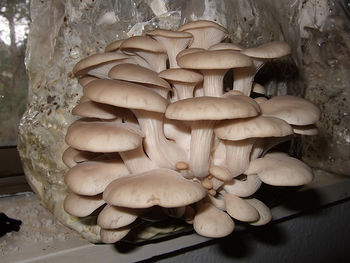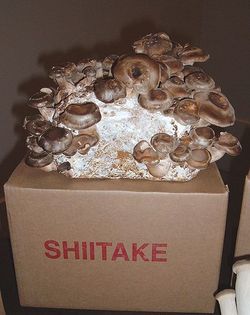Mushrooms: Difference between revisions
(→Insecticide: - added links) |
|||
| Line 48: | Line 48: | ||
Mycowizard Paul Stamets has patented a technique of using metarhizium spores to repel termites, carpenter ants and other such social insects. The fungus infects these insects, and the insects know it and stay away from any area where the spores are present. | Mycowizard Paul Stamets has patented a technique of using metarhizium spores to repel termites, carpenter ants and other such social insects. The fungus infects these insects, and the insects know it and stay away from any area where the spores are present. | ||
*http://en.wikipedia.org/wiki/Entomopathogenic_fungus | |||
*http://www.scitopics.com/Ecology_of_entomopathogenic_fungi_in_agroecosystems.html | |||
==Biofuel== | ==Biofuel== | ||
Revision as of 17:27, 15 March 2011
Main > Food and Agriculture > Controlled-environment growing
Though some mushrooms have defied the attempts of even the most expert mycologists to culture them outside of their wild environment, others grow quite readily when their spores are plugged into a suitable medium. Happily, this includes most of the tastier and more beneficial mushrooms. Mushrooms can fetch quite a high price compared to other foodstuffs, so their cultivation can be quite lucrative. Some edible mushrooms have shown impressive health benefits in studies.
Mushrooms do not like frost or very low temperatures, so they cannot be grown in winter (except perhaps in a heated indoor environment).
Types of mushrooms
- Oyster mushrooms. By far the easiest mushrooms to grow, and among the most nutritious, with 15-30% protein content. Can be grown in sterilized grain husks (an opportunity here for farms growing grains!) or in used coffee grounds (which are sterilized from when you boiled the coffee) or even in old shredded newspaper.
- Lion's Mane mushrooms.Research has found that they cause an increase in Nerve Growth Factor. Eating these literally gives you more brains.
- Reishi mushrooms.
- Turkey Tail mushrooms. Well-documented anticancer properties.
- Shiitake mushrooms. Typically grown on oak logs, but can be grown in wood chips. Has demonstrated anticancer, antibacterial and antiviral properties in trials and is also delicious.
- Maitake mushrooms. Evidence suggests that these lower blood glucose and have anticancer and immunostimulatory properties [1]
- Psilocybe genus. These are illegal to cultivate and sell in most countries. Spores are generally legal to possess, except in California, Georgia, Idaho and Germany [2]. They are harder to grow than most mushrooms, and are especially sensitive to contamination; you need to be very careful to keep the environment sterile.
Open-source mushroom growing
ArkFab have designed Spore v.0.1 "a draft prototype for a mushroom grow house that converts spent grain, spent coffee grounds, and other urban waste biomass into mushrooms and mushroom compost". Their design (page 40-52 of this pdf) costs less than $2000 in materials and is projected to grow 80lb (36kg) of mushrooms per week.
Cheap, open-source humidity sensor - very relevant to mushroom growing.
Links
- http://fungi.com/ - This site sells all kinds of mushroom growkits. They have developed a method of filling little wooden plugs with spores. 30-50 of these plugs ($3-5) can be stuck in a short log so that the mycelium completely colonize the log. Buy them at here. They also sell indoor growkits including shiitake, oyster, reishi, maitake and Lion's Mane mushrooms, all for about $26 - meaning you'd break even if you grew 4lbs
- http://www.shroomery.org/ is a great, very educational website, focused mostly, but not entirely, on psilocybin mushrooms. There is a thriving forum community full of people who know a thing or two about mushrooms. The forum includes a board on edible and medicinal mushrooms
- 12 gig torrent on permaculture, includes a folder of material from mushroom man Paul Stamets, and two instructional video series on growing mushrooms.
- Growing Gourmet And Medicinal Mushrooms and The Mushroom Cultivator books by Paul Stamets. Various techniques for cultivating different kinds of mushrooms.
Non-food uses of mushrooms
Mycoremediation
This section is a stub
Fungi were the first form of life to leave the sea and colonize the land. They prepared the earth for other life to flourish back then - and they can do it again.
Mycelium can destroy pavement and turn it into soil.
See: Mycelium Running by Paul Stamets
Composting
While food scraps will quickly break down and turn into soil, something like a log of wood will take much longer - unless you inoculate it with mushroom mycelium. Mycelium can rot a big log of wood within weeks. Growing shiitake mushrooms on a log is an excellent way to decompose the log while getting a high-value food.
Bioplastics
This section is a stub
The mycelium of certain species of mushrooms can turn grain husks into useful materials like 'Greensulate', which is a low-impact alternative to styrofoam.
Insecticide
This section is a stub
Mycowizard Paul Stamets has patented a technique of using metarhizium spores to repel termites, carpenter ants and other such social insects. The fungus infects these insects, and the insects know it and stay away from any area where the spores are present.
- http://en.wikipedia.org/wiki/Entomopathogenic_fungus
- http://www.scitopics.com/Ecology_of_entomopathogenic_fungi_in_agroecosystems.html
Biofuel
This section is a stub
Mushrooms can convert cellulose to ethanol

